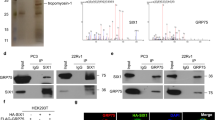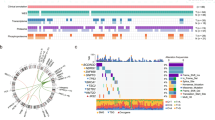Abstract
Gene associated with retinoid interferon-induced mortality (GRIM)-19, an inhibitor of transcription factor STAT3, was originally identified as a critical regulatory protein in a genetic screen that was designed to identify the gene products necessary for Interferon (IFN)-β- and retinoic acid-induced cell death. Over expression of GRIM-19 activates cell death. Conversely, inactivation of its expression promotes cell growth. STAT3 is a transcription factor that regulates gene expression in response to multiple extra cellular growth factors. In contrast to its normal feedback inhibition, a constitutive activation of STAT3 has been documented in several tumors. Although many STAT3-inhibitors are described, their relevance to human cancer is unclear. In an attempt to define the molecular alterations associated with human renal cell carcinoma (RCC) using mass spectrometry, we have discovered that expression of GRIM-19 is lost or severely depressed in a number of primary RCC and in some urinogenital tumors. Using an RCC cell line, we show that down regulation of GRIM-19 promotes tumor growth via an augmentation of STAT3-dependent gene expression. These studies for the first time show a tumor-suppressor like activity of GRIM-19.
This is a preview of subscription content, access via your institution
Access options
Subscribe to this journal
Receive 50 print issues and online access
$259.00 per year
only $5.18 per issue
Buy this article
- Purchase on Springer Link
- Instant access to full article PDF
Prices may be subject to local taxes which are calculated during checkout






Similar content being viewed by others
Abbreviations
- GRIM:
-
Gene associated with Retinoid Interferon induced Mortality
- IFN:
-
Interferon
- IP:
-
Immunoprecipitation
- MALDI-TOF:
-
Matrix-Assisted Laser Desorption Ionization-Time of Flight
- RA:
-
all-trans Retinoic acid
- RCC:
-
Renal Cell Carcinoma
- RLU:
-
Relative Light Units
- WB:
-
Western blot
References
Alexander WS, Hilton DJ . (2004). Annu Rev Immunol 22: 503–529.
Altucci L, Gronemeyer H . (2001). Nature Rev Cancer 1: 181–193.
Angell JE, Lindner DJ, Shapiro PS, Hofmann ER, Kalvakolanu DV . (2000). J Biol Chem 275: 33416–33426.
Baggetto LG . (1992). Biochimie 74: 959–974.
Bromberg JF, Wrzeszczynska MH, Devgan G, Zhao Y, Pestell RG, Albanese C et al. (1999). Cell 98: 295–303.
Buettner R, Mora LB, Jove R . (2002). Clin Cancer Res 8: 945–954.
Chidambaram NV, Angell JE, Ling W, Hofmann ER, Kalvakolanu DV . (2000). J Interferon Cytokine Res 20: 661–665.
Chung CD, Liao J, Liu B, Rao X, Jay P, Berta P et al. (1997). Science 278: 1803–1805.
Cohen HT, McGovern FJ . (2005). N Engl J Med 353: 2477–2490.
Deiss LP, Kimchi A . (1991). Science 252: 117–120.
Fearnley IM, Carroll J, Shannon RJ, Runswick MJ, Walker JE, Hirst J . (2001). J Biol Chem 276: 38345–38348.
Fischer J, Palmedo G, von Knobloch R, Bugert P, Prayer-Galetti T, Pagano F et al. (1998). Oncogene 17: 733–739.
Gao AC, Lou W, Ichikawa T, Denmeade SR, Barrett JC, Isaacs JT . (1999). Prostate 38: 46–54.
Gao L, Zhang L, Hu J, Li F, Shao Y, Zhao D et al. (2005). Clin Cancer Res 11: 6333–6341.
Gatenby RA, Gillies RJ . (2004). Nat Rev Cancer 4: 891–899.
Gresser I, Belardelli F . (2002). Cytokine Growth Factor Rev 13: 111–118.
Herman JG, Latif F, Weng Y, Lerman MI, Zbar B, Liu S et al. (1994). Proc Natl Acad Sci USA 91: 9700–9704.
Hu J, Angell JE, Zhang J, Ma X, Seo T, Raha A et al. (2002). J Interferon Cytokine Res 22: 1017–1026.
Huang G, Lu H, Hao A, Ng DC, Ponniah S, Guo K et al. (2004). Mol Cell Biol 24: 8447–8456.
Ikeda H, Old LJ, Schreiber RD . (2002). Cytokine Growth Factor Rev 13: 95–109.
Iliopoulos O, Kibel A, Gray S, Kaelin Jr WG . (1995). Nat Med 1: 822–826.
Iliopoulos O, Levy AP, Jiang C, Kaelin Jr WG, Goldberg MA . (1996). Proc Natl Acad Sci USA 93: 10595–10599.
Kalvakolanu DV . (2004). Cytokine Growth Factor Rev 15: 169–194.
Kalvakolanu DV, Choi K, Borden EC . (2001) In: Mendelsohn J, Howley PM, Israel MA, Liotta LA (eds). The Molecular Basis of Cancer. W.B Saunders Company: Philadelphia, pp 503–534.
Katula KS, Wright KL, Paul H, Surman DR, Nuckolls FJ, Smith JW et al. (1997). Cell Growth Differ 8: 811–820.
Klosek SK, Nakashiro K, Hara S, Li C, Shintani S, Hamakawa H . (2004). Oncol Rep 12: 293–296.
Knudson CM, Tung KS, Tourtellotte WG, Brown GA, Korsmeyer SJ . (1995). Science 270: 96–99.
Lang R, Pauleau AL, Parganas E, Takahashi Y, Mages J, Ihle JN et al. (2003). Nat Immunol 4: 546–550.
Latif F, Tory K, Gnarra J, Yao M, Duh FM, Orcutt ML et al. (1993). Science 260: 1317–1320.
Levy DE, Darnell JE . (2002). Nat Rev Mol Cell Biol 3: 651–662.
Lindner DJ, Ma X, Hu J, Karra S, Kalvakolanu DV . (2002). Clin Cancer Res 8: 3210–3218.
Lowe SW, Bodis S, McClatchey A, Remington L, Ruley HE, Fisher DE et al. (1994). Science 266: 807–810.
Lubensky IA, Schmidt L, Zhuang Z, Weirich G, Pack S, Zambrano N et al. (1999). Am J Pathol 155: 517–526.
Lufei C, Ma J, Huang G, Zhang T, Novotny-Diermayr V, Ong CT et al. (2003). EMBO J 22: 1325–1335.
Maximo V, Botelho T, Capela J, Soares P, Lima J, Taveira A et al. (2005). Br J Cancer 92: 1892–1898.
Maxwell PH, Wiesener MS, Chang GW, Clifford SC, Vaux EC, Cockman ME et al. (1999). Nature 399: 271–275.
Moore DM, Kalvakolanu DV, Lippman SM, Kavanagh JJ, Hong WK, Borden EC et al. (1994). Semin Hematol 31: 31–37.
Morris MR, Maina E, Morgan NV, Gentle D, Astuti D, Moch H et al. (2004). J Clin Pathol 57: 706–711.
Pingoud-Meier C, Lang D, Janss AJ, Rorke LB, Phillips PC, Shalaby T et al. (2003). Clin Cancer Res 9: 6401–6409.
Pollard PJ, Briere JJ, Alam NA, Barwell J, Barclay E, Wortham NC et al. (2005). Hum Mol Genet 14: 2231–2239.
Pollard PJ, Wortham NC, Tomlinson IP . (2003). Ann Med 35: 632–639.
Radaeva S, Jaruga B, Hong F, Kim WH, Fan S, Cai H et al. (2002). Gastroenterology 122: 1020–1034.
Schmidt L, Duh FM, Chen F, Kishida T, Glenn G, Choyke P et al. (1997). Nat Genet 16: 68–73.
Seo T, Lee D, Shim YS, Angell JE, Chidambaram NV, Kalvakolanu DV et al. (2002). J Virol 76: 8797–8807.
Sherr CJ, McCormick F . (2002). Cancer Cell 2: 103–112.
Shim H, Dolde C, Lewis BC, Wu CS, Dang G, Jungmann RA et al. (1997). Proc Natl Acad Sci USA 94: 6658–6663.
Simpson RJ . (2003). Proteins and Proteomics: A Laboratory Manual. Cold Spring Harbor Laborator Press: Cold Spring Harbor, New York.
Skehan P, Storeng R, Scudiero D, Monks A, McMahon J, Vistica D et al. (1990). J Natl Cancer Inst 82: 1107–1112.
Soengas MS, Capodieci P, Polsky D, Mora J, Esteller M, Opitz-Araya X et al. (2001). Nature 409: 207–211.
Stupack DG, Teitz T, Potter MD, Mikolon D, Houghton PJ, Kidd VJ et al. (2006). Nature 439: 95–99.
Tanaka N, Ishihara M, Lamphier MS, Nozawa H, Matsuyama T, Mak TW et al. (1996). Nature 382: 816–818.
Thacher SM, Vasudevan J, Chandraratna RA . (2000). Curr Pharm Des 6: 25–58.
Trovato M, Vitarelli E, Grosso M, Alesci S, Benvenga S, Trimarchi F et al. (2004). Eur J Histochem 48: 291–297.
Venkitaraman AR . (2002). Cell 108: 171–182.
Vogelstein B, Lane D, Levine AJ . (2000). Nature 408: 307–310.
Willman CL, Sever CE, Pallavicini MG, Harada H, Tanaka N, Slovak ML et al. (1993). Science 259: 968–971.
Xu Q, Briggs J, Park S, Niu G, Kortylewski M, Zhang S et al. (2005). Oncogene 24: 5552–5560.
Yang J, Chatterjee-Kishore M, Staugaitis SM, Nguyen H, Schlessinger K, Levy DE et al. (2005). Cancer Res 65: 939–947.
Yoshikawa H, Matsubara K, Qian GS, Jackson P, Groopman JD, Manning JE et al. (2001). Nat Genet 28: 29–35.
Zhang J, Yang J, Roy SK, Tininini S, Hu J, Bromberg JF et al. (2003). Proc Natl Acad Sci USA 100: 9342–9347.
Zhang X, Huang Q, Yang Z, Li Y, Li CY . (2004). Cancer Res 64: 2474–2481.
Zhuang Z, Park WS, Pack S, Schmidt L, Vortmeyer AO, Pak E et al. (1998). Nat Genet 20: 66–69.
Acknowledgements
DVK thanks the National cancer Institute for Grant support CA105005 and CA78286. SPR is supported by NIH grants ES11863 and HL66109.
Author information
Authors and Affiliations
Corresponding author
Rights and permissions
About this article
Cite this article
Alchanati, I., Nallar, S., Sun, P. et al. A proteomic analysis reveals the loss of expression of the cell death regulatory gene GRIM-19 in human renal cell carcinomas. Oncogene 25, 7138–7147 (2006). https://doi.org/10.1038/sj.onc.1209708
Received:
Revised:
Accepted:
Published:
Issue Date:
DOI: https://doi.org/10.1038/sj.onc.1209708
Keywords
This article is cited by
-
Mitochondrial GRIM-19 deficiency facilitates gastric cancer metastasis through oncogenic ROS-NRF2-HO-1 axis via a NRF2-HO-1 loop
Gastric Cancer (2021)
-
Heterogeneity of GRIM-19 Expression in the Adult Mouse Brain
Cellular and Molecular Neurobiology (2019)
-
Renal Cell Carcinoma: Molecular Aspects
Indian Journal of Clinical Biochemistry (2018)
-
GRIM-19 mutations fail to inhibit v-Src-induced oncogenesis
Oncogene (2014)
-
Oncogenic K-ras expression is associated with derangement of the cAMP/PKA pathway and forskolin-reversible alterations of mitochondrial dynamics and respiration
Oncogene (2013)



